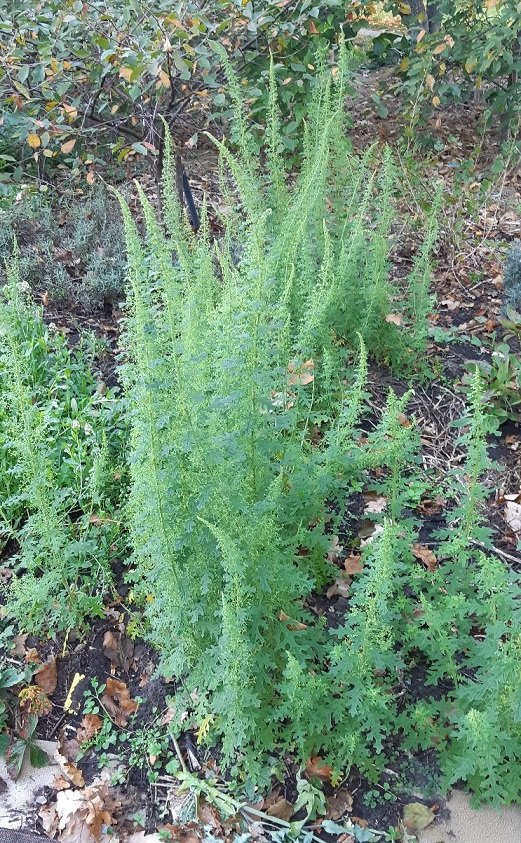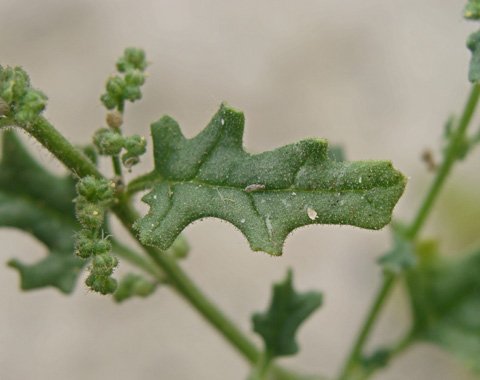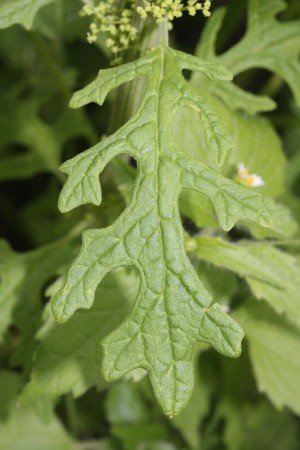You will not find information about Shrader’s Balm in conventional herbal medicine books. Shrader’s Balm, Chenopodium (Dysphania) shraderianum Shult., represents a rare case of a non-native plant traditionally used in a specific European region, yet until recently almost entirely absent from European ethnobotanical literature. It is documented chiefly by ethnobotanists, but it still remains quite enigmatic to phytotherapists and modern pharmacy.

A Chance Encounter
This plant arrived in my garden by chance—uninvited. On the contrary, most such plants find their way to me. A few years ago, on a gloomy Advent evening, I was tempted to attend a lecture by the herbalist Dalia Petraitienė on plants that affect our psychology. The lecture, held in Kaunas, saw us tying incense bouquets while Dalia spoke about “kietis” and other plants she had brought with her. A bundle of long, exceedingly fragrant dried plants captivated me. “Perhaps that scent…” Dalia called it “myrrh.” I noticed some seeds on the fabric beneath the dried plants, requested them, and took some along.
The Arrival of a Mystery
Thus, under the names “mira,” “ilgauodegė,” “pabrėžinė,” “marinė šanta,” or simply Shrader’s Balm (Chenopodium (Dysphania) shraderianum Shult.), the plant entered my life. It arrived quietly, reluctant to reveal itself. Mysterious indeed.
Ethnobotanical Background
You will not find further information about this plant in standard herbal medicine books. Dysphania schraderiana is a rare instance where a non-native plant is traditionally used in a specific European territory, yet was almost entirely unnoticed in European ethnobotanical literature. It is primarily described by ethnobotanists, but it still remains rather mysterious to phytotherapists and modern pharmacy.
Recent Ethnopharmacological Insights
Polish ethnopharmacologists published a study in 2022 that helped partially lift the veil of mystery surrounding this plant. The study even explains why, among us, it is sometimes called “myrrh.” In the southeastern region of Poland, the plant has been used—and continues to be used—in churches for incense and in bouquets blessed during services and other ceremonies. Although its scent does not resemble the resin of Commiphora myrrha (which, together with frankincense, is burned during rituals), in the absence of or due to the high cost of the latter, Shrader’s Balm has served as an excellent substitute.
A Matter of Confusion: Similar Species
One possible reason this plant remains relatively unknown is its similarity to another member of the goosefoot family, Chenopodium botrys. You will read more about both later in the text, but for now I wish to share what Gražina Žumbakienė, a Lithuanian ethnobotanist, has written about Shrader’s Balm:
“In the early 20th century, Shrader’s Balm was the most commonly cultivated plant in Žemaitija. It was used to treat both animals and people. It was employed against women’s ailments—women treasured it, deeming it worth more than gold. A woman is saved by this herb only when blood appears… It was given to animals after colic and was mixed with other herbs such as takažolės, medetkų, and katžolių. Shrader’s Balm, together with parsley leaves, was used to treat kidney diseases. Both animals and people were given it to drink to relieve colic when the bowels were disturbed. It was even consumed during bouts of diarrhea.”
Chenopodium botrys – The Hundred-Seed Balm

Chenopodium botrys (also known as Dysphania botrys [Schult.])—the Hundred-Seed Balm or “šimtagrūde kirmžole”—originates from Southern Europe, from Spain extending to the western Himalayas and Mongolia. It is considered native to Hungary and Ukraine, though not in Poland or Germany. This aromatic annual or biennial herb was modestly used in Antiquity and is mentioned in the works of Dioscorides (as βότρυς), Aegineta, and Pliny. It was not noted by Galen, Aetius, Oribasius, Celsus, and likely by any Arab herbalist except Ibn al-Baitar.
D. botrys also appears in European herbals from the 16th to the 18th century. It is mentioned by Matthioli (as “botrys” in Dioscorides’ guide) and by Tabernaemontanus, while Dodoneus (1583) recommended it for melancholy and described a medicinal wine and a herbal preparation with sugar. Later authors such as Bauhin, Gerard, and Parkinson referred to it as “oke of Jerusalem” or the “Jerusalem oak” (Morteza-Semnani, 2015). In strict pharmacopoeial monographs, D. botrys is mentioned by Schweckenfeld (1600) in the Silesian materia medica (from present-day Polish territory), where he called it uva botrys (Traubenkraut, Lungenkraut, and Mottenkraut). He recommended the plant for treating chest and tracheal phlegm, asthma, heart and lung diseases, postpartum pains, and as an insect repellent—especially against lice and cockroaches. Cartheuser (1769) considered the pharmacological uses of D. botrys and D. ambrosioides to be similar.
Dysphania schraderiana – Shrader’s Balm

Dysphania schraderiana (Schult.) Mosyakin & Clemants (formerly known mostly as Chenopodium foetidum Schrad. or Ch. schraderianum Schult.) is a species closely related to D. botrys, but originating from Africa and the Arabian Peninsula. Until the 19th century, D. schraderiana was absent from European literature. It was identified by Schrader in 1808 (as Chenopodium foetidum Schrad.); however, European botanical texts published before 1808 might mention a plant named Chenopodium foetidum or Ch. foetidum Lam., which refers to another species now accepted as Chenopodium vulvaria L. (known as “Balanda smirduolė”).
Although little known to European botanists and pharmacists, D. schraderiana has been traditionally used in its native region. In Yemen, its seeds and leaves are used to treat intestinal worms, and the seeds are employed to heal fruits (Hussein and Dhabe, 2018). In Ethiopia, it is called “yocho,” and its seeds are used to treat dysentery, headaches, and eye diseases (Awas and Demissew, 2009). In Traditional Chinese Medicine, D. schraderiana was applied to treat a hoarse cough (asthma), inflammation, spasms, and migraine (Xie, 1996). It later spread to other parts of Asia (Uotila, 2013) and Europe, where it is occasionally found wild in central and southeastern regions. According to Polish materia medica author Sawiczewski (1839), the species was found only in botanical gardens. D. schraderiana is not officially recorded in European herbaria, though it might have been used mistakenly as D. botrys. If differences were noted, it was likely considered “false” D. botrys, having a less desirable, sharper odor. This is confirmed by Czerwiakowski’s (1859) “Opisanie roślin,” the only pharmaceutical document in Poland comparing these two species. Czerwiakowski described it as “a stimulating, anti-inflammatory herb that was once a vital remedy, but on a local scale was still used as a treatment for worms.” He further mentions D. schraderiana by its old name Ch. foetidum Schrad., noting: “It is much taller, less sticky, with deeper leaves, and its upper trilobed, sharply toothed fruit envelopes are considered to belong only to the first variety. It is used in a similar manner.” According to Hager (1876), D. schraderiana in European pharmacies was also regarded as a substitute for Ch. ambrosioides.
Uses of Shrader’s Balm
Religious and Ritual Applications
According to our Polish neighbors—likely the very source from which this plant and its name “myrrh” arrived—the principal use of Shrader’s Balm is in blessing rituals performed in churches, which still hold great significance for some rural communities. This plant is most commonly blessed on the Feast of the Assumption (August 15) and is also incorporated into wreaths blessed during the celebration of Christ’s Nativity. Moreover, it is used on Epiphany (January 6) as incense to perfume homes. Dried, crushed plant material has been used as an additive in church incense.

A bouquet of Dysphania schraderiana, blessed on September 9, 2015, in Siedliska (near Žešuva). Photo: Ł.Ł.
Medicinal and Therapeutic Uses
Dried myrrh twigs are also used in medicine: burned as incense or brewed into tea to relieve sore throats, reduce fever, treat cancer, and soothe inconsolably crying children. Another important use is as an insect repellent, commonly employed in closets and in storage areas for grains or flour.
Protective Uses
An interesting application of myrrh occurs in funeral rituals. Until the turn of the 20th to 21st centuries, the bodies of the deceased were kept at home for a couple of days before the funeral. In Markova, the deceased’s body was adorned with wreaths from the Myrrh Octave of the Baptism of the Body. In Dębów, branches of the plant or bouquets blessed on the Feast of the Assumption—infused with myrrh, partly for their aroma and partly “so that Mary might carry them to heaven”—were placed upon the head of the deceased.
Myrrh was also used as a protective charm when building a new house. In Straszydle, branches of this species were placed at the four corners of the foundation, while in Markova, Myrrh Octave wreaths containing D. schraderiana were used instead. There are also accounts that it was placed in kitchens as a spice and to enhance the aroma of dishes.
Personal Reflections and Traditional Wisdom
For me, however, this mysterious balm is most enchanting when enjoyed as a tea. With its subtle, earthy, resinous flavor, on a cold winter evening it soothes and grounds me, instilling hope that the sun will shine again soon and that we will revive alongside nature. I cherish myrrh both as incense—whether in bouquets or in powdered form—as I recalled at the very start of our meeting during Dalia’s lecture.
Our acquaintance with Shrader’s Balm has only just begun. There remain many mysterious lessons to learn from it, and I invite you to join me on this journey of discovery.
You can purchase Shrader’s Balm here.
Literature:
- Dysphania schraderiana (Schult.) Mosyakin & Clemants – A little-known medicinal and ritual plant used in Poland. Link
- G. Žumbakienė, Senieji Lietuvos gėlių darželiai, Lithuanian Museum of Folk Life, 2021

